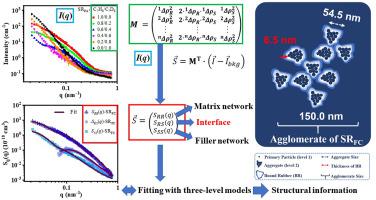Composites Science and Technology ( IF 8.3 ) Pub Date : 2021-09-02 , DOI: 10.1016/j.compscitech.2021.109024 Yue Shui 1 , Lizhao Huang 1 , Chengsha Wei 2 , Guangai Sun 1 , Jie Chen 1 , Ai Lu 2 , Liangwei Sun 1 , Dong Liu 1

|
Aiming to unveil the correlation among formula, hierarchical structure, and performance of silica filled silicone rubber foams (SRFs), mechanical and structural investigations are performed on three selected samples. Precipitation (P) and fumed (F) silica filled SRFs with diameters of primary particles around 20 nm (PA), 16 nm (FB), and 14 nm (FC) are used, namely SRPA, SRFB, and SRFC. The hierarchical structures are obtained by contrast variation-small-angle neutron scattering (CV-SANS) with an established three-level unified Guinier-exponential/power-law approach. The sizes of both aggregates (agg) and agglomerates (agl) levels have the correlation of SRPA > SRFB > SRFC. Mass-fractals df, agg of SRPA, SRFB, and SRFC are 2.16, 2.16, and 2.54, while df, agl of the set are 2.90, 2.52, and 2.54, respectively. CV-SANS also indicates that the static thickness of bound rubber (TSBR) of SRPA, SRFB, and SRFC decreases from 10.3 nm to 7.5 nm, and then to 6.5 nm. Interestingly, low-field 1H nuclear magnetic resonance (NMR) indicates that the dynamics thickness of bound rubber (TNBR) of the set increases from 3.33 nm to 4.35 nm, and then to 4.41 nm. The discrepancy between TSBR and TNBR is ascribed to the interface interaction. Mechanically, three samples present different behaviors, while SRPA and SRFB have similar extension modules and compressive relaxations. According to a modified constitutive model fitting, and with combining the structural information, the roles of filler-filler and filler-rubber interactions on the reinforcement of SRFs are discussed.
中文翻译:

二氧化硅如何通过形成填料网络和结合橡胶来决定填充硅橡胶的性能
为了揭示二氧化硅填充的硅橡胶泡沫 (SRF) 的配方、层次结构和性能之间的相关性,对三个选定的样品进行了机械和结构研究。使用沉淀 (P) 和气相法 (F) 二氧化硅填充 SRF,初级粒子的直径约为 20 nm (PA)、16 nm (FB) 和 14 nm (FC),即 SR PA、SR FB和 SR FC。层次结构是通过对比变化小角度中子散射 (CV-SANS) 与既定的三级统一吉尼尔指数/幂律方法获得的。聚集体( agg ) 和附聚物( agl ) 水平的大小具有SR PA > SR FB的相关性。 > SR FC。SR PA、SR FB和SR FC 的质量分形d f、agg分别为2.16、2.16 和2.54,而该集合的d f、agl分别为2.90、2.52 和2.54。CV-SANS还表明,结合橡胶(静态厚度Ť小号BR SR的)PA,SR FB,和SR FC降低从10.3纳米至7.5纳米,然后到6.5纳米。有趣的是,低场1 H 核磁共振 (NMR) 表明结合橡胶的动力学厚度 ( T N BR) 从 3.33 nm 增加到 4.35 nm,然后增加到 4.41 nm。T S BR和T N BR之间的差异归因于界面交互。在机械上,三个样品表现出不同的行为,而 SR PA和 SR FB具有相似的扩展模块和压缩松弛。根据改进的本构模型拟合,并结合结构信息,讨论了填料-填料和填料-橡胶相互作用对 SRF 增强的作用。











































 京公网安备 11010802027423号
京公网安备 11010802027423号